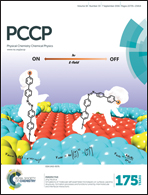A two excited state model to explain the peculiar photobehaviour of a flexible quadrupolar D–π–D anthracene derivative†
Abstract
The peculiar photobehaviour of a symmetrical arylenevinylene anthracene derivative bearing mild electron donors (alkoxy groups) at the sides of its structure has been fully comprehended through this study. An investigation into the effect of solvent polarity and temperature on the stationary fluorescence spectrum allowed a clear dual emission to be revealed. A further valuable insight was obtained, thanks to the employment of ultrafast spectroscopies. Fluorescence up-conversion measurements and the Time Resolved Area Normalised Spectra analysis provided a clear-cut proof of the presence of two distinct fluorescent states (1A* and 1B*), with 1A* being responsible for the steady-state emission in highly polar and viscous media. Femtosecond transient absorption spectra were acquired in several organic solvents of different polarity and viscosity. Interestingly, the lifetime of 1A* was found to be dependent on solvent viscosity whereas the lifetime of 1B* showed a trend which matches the change in solvent polarity. Indeed, the Density functional theory calculations predicted a structural rearrangement in the fully relaxed lowest excited singlet state. The 1A* → 1B* transition is thus likely accompanied by large amplitude motions of the molecular structure, with the 1B* state also exhibiting a small intramolecular charge transfer character. The investigated flexible quadrupolar D–π–D system arouses therefore great interest as a novel material for applications in organic electronics and photonics.


 Please wait while we load your content...
Please wait while we load your content...